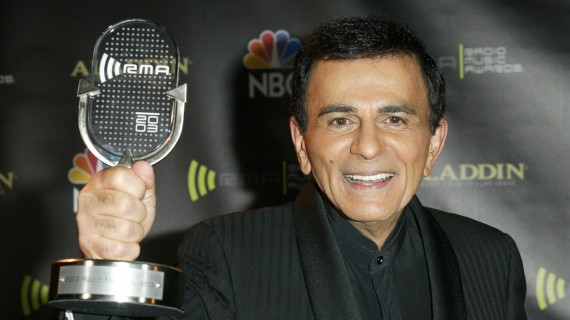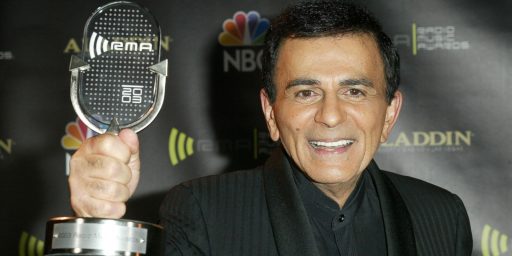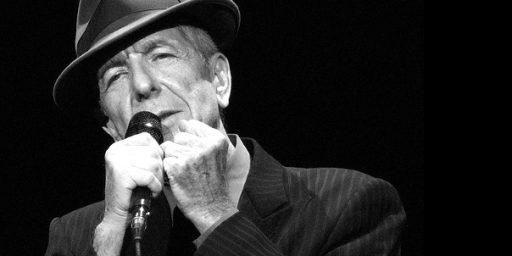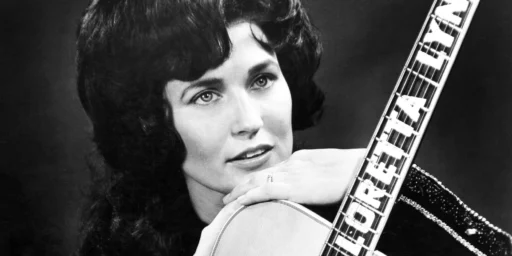Casey Kasem Dead at 82
Casey Kasem, who became a legend in radio as host of American Top 40 as well as providing the voice to cartoon characters for more than 40 years, has died at the age of 82 after a prolonged illness:
Casey Kasem, the resonant voice of Top 40 radio and a vocal fixture on cartoon programs for the past 40 years, has died, according to his daughter. He was 82.
Kasem died Sunday of Lewy body disease, a common form of progressive dementia. Daughter Kerri Kasem confirmed her father’s death in a Facebook post on Father’s Day.In May, his second wife Jean Kasem and her stepchildren waged a public fight over what daughter Kerri claimed were Jean’s efforts to prevent her from visiting her father. The dispute went to court as reports spread that Casey Kasem’s whereabouts could not be confirmed. Kerri Kasem was ultimately granted visitation rights to her father and the right to make medical decisions on his behalf.
He became a national fixture starting in 1970 as host of the syndicated radio program “American Top 40.”
The format was simple — Kasem counted down the week’s top pop hits with a bit of trivia about the artists, color and feel-good anecdotes mixed in. His relentlessly upbeat outlook was embodied in the catchphrase that he used to close every show: “Keep your feet on the ground, and keep reaching for the stars.” Kasem hosted the show until 1988. At its peak, “American Top 40″ was carried on more than 1,000 stations around the world.
He also did TV voiceover work and provided the voice of Shaggy on the Hanna-Barbera cartoon series “Scooby-Doo, Where Are You?,” among other animated programs. He continued to voice Shaggy and other Scooby-Doo characters for various productions as late as 2009. He also provided many voices for “Sesame Street” and the voice of the title character in the Rankin/Bass production of “Here Comes Peter Cottontail.” In addition he was heard in a vast number of commercials.
As “American Top 40″ took off, the diminutive Kasem began logging screen roles in 1970s TV shows and movies, such as “Emergency,” “Hawaii Five-O,” “Ironside” and “Charlie’s Angels.” And he continued to do a wide range of voiceover work for TV. In In 1984, Kasem cameo’d in the film “Ghostbusters” in his role as host of “American Top 40.”
For most of the period from 1980 to 1992, Kasem also hosted the syndicated weekly half-hour TV series “America’s Top 10,” a spinoff of “American Top 40″ that counted down the top 10 songs in the U.S.
Kemal Amin Kasem was born in Detroit to parents who were Lebanese Druze immigrants. He graduated from Wayne State University. Kasem got his start in radio during the Korean War working for Armed Forces Radio. After he left the service and returned the U.S., he worked for numerous radio stations as a disc jockey.
Kasem was inducted into the National Association of Broadcasters Hall of Fame in 1985 and the National Radio Hall of Fame in 1992.
More from The New York Times:
Mr. Kasem’s “American Top 40,” which first aired in the summer of 1970, was a weekly four-hour feast of homey sentiment and American optimism that ran headlong into the prevailing spirit of rebellion in the music culture of the day.
The show gave new life to the top 40 format at a time when the popularity of the 45 r.p.m. was waning and FM disc jockeys were experimenting with more personal formats, creating playlists from their favorite long-playing album cuts.
Mr. Kasem, instead, featured only the singles that Billboard magazine had ranked as the country’s most popular in the past week, based on its analysis of airplay — a playlist, in effect, based on the national pop consensus.
Building a radio show on the notion that such a consensus existed was considered a risky proposition in that culturally splintered time. As Time magazine put it, “He embraced corniness as Vietnam-era cynicism peaked.” But the format struck a chord.
Only five radio stations carried the debut of “American Top 40” on July 4, 1970. But within a year more than 100 did, and by the mid-’70s it had reached nearly 1,000 outlets “coast-to-coast,” as Mr. Kasem liked to say, making him one of the best-known D.J.’s in the country.
He had modeled the show, he later told interviewers, on the old NBC radio program “Your Hit Parade” (also known as “The Lucky Strike Hit Parade”). “I thought we’d be around for at least 20 years,” he said. “Because I knew the formula worked.”
“American Top 40” became a mainstay of American radio, offering a crowd-pleasing menu of hits seasoned with Mr. Kasem’s heartfelt readings of listeners’ song dedications, wholesome anecdotes about the lives of the pop stars, and an endless store of solid, if cringe-inducing, pieces of advice, like his touchstone signoff: “Keep your feet on the ground and keep reaching for the stars.”
(Not all the dedications were necessarily feel-good, however. A pregnant teenager addressed her boyfriend in prison, for example, and a mother begged her runaway daughter to come home.)
Mr. Kasem also hosted a syndicated television version of the show in the 1980s. But his relationship with “American Top 40” ended in 1988 because of a contract dispute with his syndication company. The next year, he started “Casey’s Top 40,” a competing radio program on another network, bringing most of his old audience there with him.
About 10 years later, after acquiring the rights to the name, he was again hosting a show with the title “American Top 40” (and for a time hosted both that and the competing “Casey’s Top 40.”) He ended his three-decade run in 2004, handing the hosting duties to Ryan Seacrest, who continues in that role. Mr. Kasem retired in 2009.Rock ‘n’ roll was never his passion, he told interviewers. He knew his subject, and kept up with it in a professional way, but when home, he told Billboard, “I find myself just wanting to sit in my office and make it as quiet as possible.”
“If I were doing a real rock show,” he told The New York Times in 1990, “then it would matter to know how I felt about what I was playing.” But, he added, “I’m just counting them down as they appear on the chart, 1 through 40. What really matters is what I say between the songs.”
Between the songs Mr. Kasem managed to herald the newest of the new with a broadcast style that felt comfortingly old. He set the tone with a neighborly but precise 1940s-style diction, honed to amiable perfection in a second career as a voice-over artist. With plain-spoken warmth and a partiality to sentiments and phrases (“coast to coast” and “sweetheart” were his favorites, hands down), his delivery evoked another time.
“Hello again, everybody,” he said to open most of his shows. “I’m Casey Kasem, and welcome to ‘American Top 40.’ I’m all set to count down the 40 most popular songs in the U.S.A.”
When he used biographical teasers to introduce songs (“a high school dropout and a runaway, with a mother who was married six times — coming up,” referring to Cher), Mr. Kasem echoed Paul Harvey on his folksy, long-running news broadcasts. But he told The Times that the technique harked back to his childhood in a Middle Eastern immigrant neighborhood of Detroit.
“I was drawing on the Arabic tradition of storytelling one-upmanship,” he said. “When I was a kid, men would gather in my parents’ living room and tell tales and try to outdo each other. I couldn’t understand the language, but I was fascinated.”
Most recently, of course, Kasem was in the news due to disputes between his wife and the children from his first marriage, who accused their stepmother of hiding Kasem and restricting their ability to visit him in what were obviously his final days. After a judge ordered an investigation and Kasem was located in Washington State, the dispute evolved into one between the children and the stepmother over Kasem’s treatment. Just a few days ago, a Judge ruled that the children would be authorized to order doctors to abide by the terms of Kasem’s previous medical directives, which included the withholding of treatment.
Like many who grew up in the 70s I would imagine, I was a frequent listener of American Top 40, although for some reason I didn’t realize that he also provided voices on Scooby-Doo until some later point in time. In any case, Kasem certainly had one of the most distinctive voices of his era and, much like Dick Clark, a clear appreciation for the music he played.
Of course, sometimes even someone as seemingly even-tempered as Kasem would lose it:
Honestly, I can see his point.







Sad but not unexpected if you’ve been following the family drama. There’s a special place in hell for second wives who deprive children access to their fathers as they lay on their deathbed.
Died on Father’s Day…Life and Death can be a bitch (or a bastard) sometimes.
1) I also didn’t realize he was Shaggy until these past couple days, although it’s sort of obvious in hindsight (my wife always recognizes voice actors, while I always seem to involved in the story to notice).
2) Cool story, bro – I also just learned that he attended Wayne State University at the same time as my dad, although with a few years difference and completely different majors.
Anyway, seemed like a cool guy.
@James Pearce:
I certainly hope so.
(… no, I don’t want to get into it. Yes, she took everything.)